“In so little room as the state of Israel and the Palestinian territories, there is entirely too much hatred,” said Patrick J. Ryan, S.J., Laurence J. McGinley Professor of Religion and Society. “Notice that I call all three of these territories the Holy Land. We must keep in mind that all three of these territorial divisions are holy for Jews, holy for Christians, and holy for Muslims, but holy for each faith community in a different way.”
The history of religious ties to the area and how they impact the present-day conflicts were the central themes of the fall McGinley lecture titled, “Faith and Conflict in the Holy Land: Peacemaking Among Jews, Christians and Muslims.”
The lecture and panel discussion, which took place on Nov. 12 and Nov. 13 at the Lincoln Center and Rose Hill campuses, respectively, featured a keynote speech from Father Ryan followed by two respondents—Ebru Turan, Ph.D., history professor at Fordham, and Abraham Unger, Ph.D., GSAS ’92, ’07, campus rabbi and associate professor of government and politics at Wagner College.
‘Perpetual Migrants’
Father Ryan highlighted in his lecture that “nobody comes from nowhere” and that “all of us are both native and immigrant.”
Unger, who delivered the Jewish response, emphasized the fact that Jewish people, in particular, have been considered “perpetual migrants” and that this view of their history needs to be taken into account when thinking about present-day Israel and Palestine.
“I suggest the conflict reaches into the existential nature of the Jewish people itself, both for Jews and for the rest of the world when thinking about Jews,” Unger said.
The Jewish identity, according to Unger, has always included a sense of being a “marginalized outsider” or watching for the next wave of oppression. That’s why the desire for a homeland is so essential, he said.
If the conflict is looked at under that lens, Unger said, it can be seen as bigger than simply “how much area Jews and Arabs ought to respectively get out of the Holy Land.”
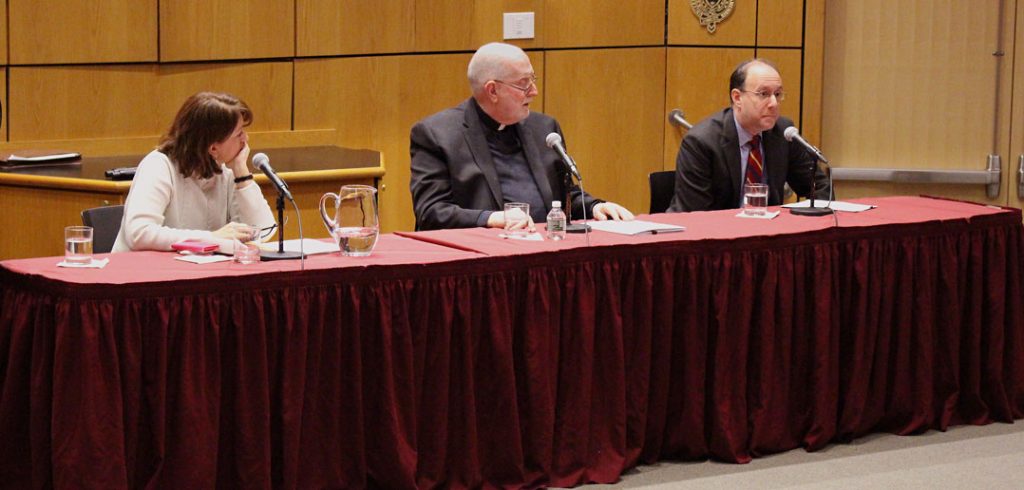
Sacred Sites of Significance
For Christians, the Holy Land is not “a major theme in Christian scriptural sources,” Father Ryan said, although Christians as early as the second century took an interest in the area, and that interest grew following the reign of Constantine.
“To Constantine we owe the location of the place in Jerusalem where Jesus died, was buried, and rose again—now the Church of the Holy Sepulcher,” Ryan said, noting that the Roman emperor commissioned the church. “Helena [Constantine’s mother] is said to have built the original Basilica of the Nativity in Bethlehem and an oratory on the Mount of Olives, marking the locale where the disciples witnessed the ascension of Jesus.”
In the Islamic tradition, the “sanctity of the Holy Land in Islam is concentrated in one particular spot in Jerusalem called the Noble Sanctuary,” said Turan, who delivered the Islamic response.
“The Noble Sanctuary houses two of the most sanctified and majestic monuments of Islam—the Dome of the Rock and the Aqsa Mosque,” she said, identified by Islamic authorities as the site of the Prophet Mohammad’s night journey and heavenly ascension.
Present-Day Challenges
Understanding these diverse religious ties to the Holy Land can help people better understand the ongoing conflict in the Middle East, according to the speakers. Still, they said there were no easy solutions.
“How can we have a safe Israel within its borders? On the other hand, how can we have a sovereign Palestine state with its own government and arms—these two are not compatible.” Turan said, stating that she still wished for peace. “That’s why it is not that easy, because the space is very, very tight.”
Unger highlighted another challenge: The area has seen its Christian population, which had oftentimes eased tensions between the Jewish and Muslim populations, decrease rapidly.
“There’s a tremendous Palestinian-Christian diaspora emerging,” he said. “This is a great loss for the majority Jewish population because the Christian-Arab population sometimes has been and also can be a bridge between the Muslim majority within the Arab sector…as well as a bridge to the West itself and to the Jewish majority.”
A Dream of Peace
Father Ryan, however, encouraged the next generation to look to history and then try to find a way forward.
“I have shared with you this evening my dream—an old man’s dream—in the hope that some young people here will see visions, visions of peacemaking in the Holy Land, peacemaking in every land,” Father Ryan said.
]]>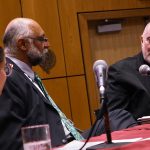
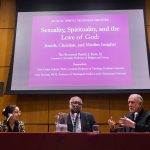
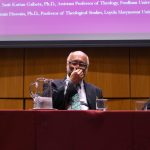
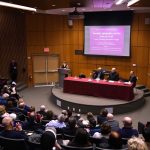 Three members of different faiths—Judaism, Christianity, and Islam—considered the connection between sexuality and spirituality at the 2019 Spring McGinley Lecture, held on April 9 and 10 at the Lincoln Center and Rose Hill campuses.
Three members of different faiths—Judaism, Christianity, and Islam—considered the connection between sexuality and spirituality at the 2019 Spring McGinley Lecture, held on April 9 and 10 at the Lincoln Center and Rose Hill campuses.
This conversation is more critical than ever, said keynote speaker, Patrick J. Ryan, S.J., the Laurence J. McGinley Professor of Religion and Society. In the wake of the Catholic Church’s sexual abuse scandal, it is important to recognize that sexuality has a sacred meaning in each religion.
“I want to draw your attention to how very human forces, male and female, interact with each other in the imaginative creation of worlds of faith, worlds of spirituality,” Father Ryan said. “How, in particular, do our understandings of human sexuality color how those of us who are Jews, Christians, and Muslims think about God?”
The Bible says that God created Adam, the first human being, as both male and female. (Eve was created from one of Adam’s ribs.) This duality continues to be found in all aspects of life, including marriage, Father Ryan said. It can also be seen in male and female images in the Book of Genesis and the Song of Songs. But one of the most important texts in Judaism, the Zohar, takes a step further and suggests that humanity itself “mirrors and magnifies the Lord God,” he said.
In the same vein, Christian texts show spirituality through sexuality. For example, an autobiography by Saint Teresa of Avila, a 16th-century Christian mystic and writer, portrays the soul and God as passionate lovers, Father Ryan said. She uses graphic imagery to show the angelic piercing of her heart with the spear of God’s love: “When he drew it out, I thought he was drawing them [her entrails]out with it and he left me completely afire with a great love for God.”
The Quran also denotes spirituality through sexual language, he said. The basmalah blessing, which begins every chapter of the Quran but one, uses words that associate “the mercy of God” with a mother’s womb.
“To connect the mercy of God with a feminine physical characteristic is to understand God’s perfection as including all that is most tender in created reality, including the generative and loving characteristics of others,” Father Ryan said.
Although much of the main lecture focused on heterosexual love, respondent Amir Hussain, Ph.D., professor of theological studies at Loyola Marymount University, took a detour from the night’s discourse to reflect on the dangers faced by the LGBTQ community.
“I think of Islamic psychologists from Los Angeles, where I live, who worry about losing their license if they are anything but heteronormative,” he said. “And I wonder how we got to that place where we can hate people for the love that God has put between them.”
For Hussain, it’s a personal issue, as he was an undergraduate at the University of Toronto during the “plague years” of the ’80s, when he said he attended one too many funerals for his friends who died of HIV and AIDS.
“We have to speak out when our gay, lesbian, queer, trans, and bisexual brothers and sisters are threatened,” Hussain said. “We have to lift up the work and voices of LGBTQ scholars and activists, such as Scott Kugle at Emory University, who remind us of the inherent dignity of all of us—regardless of our sexuality.”
The scholar who delivered the Jewish response, Sarit Kattan Gribetz, Ph.D., assistant professor of theology at Fordham, compared two Biblical texts from the Old Testament: Song of Songs and Ezekiel 16. Both stories use the metaphor of a romantic partnership to show God’s relationship with Israel, she said. Only one relationship is healthy though, while the other is marred by manipulation and abuse.
Gribetz’s juxtapositions were often stark. In Song of Songs, the narrator portrays a romantic relationship between a man (God) and a woman (Jerusalem as the spouse of the Lord). Gribetz described the scenes that unfold between the lovers: “A series of kisses, love described as sweeter than wine, fragrant oils, and secluded chambers.”
Ezekiel 16, by contrast, takes a tragic turn. In it, God (a man) saves the people of Jerusalem (a woman) from slavery in Egypt, but is betrayed by the very people he rescues. The text is fraught with dark imagery: an unbathed newborn lying in the blood of her after-birth, nakedness, suffering, and violent threats.
But in these two texts, there is something to be said about humanity, Gribetz said. The stories paint a realistic portrait of the possible intersections among sexuality, spirituality, and love of God—both positive and negative.
“I chose to share with you this evening not only the positive but also the negative, not only the benevolent but also the malevolent, to highlight the empowering dimensions of religious texts, but also to acknowledge those parts of our traditions that are most problematic,” Gribetz said.
“So that we can imagine and construct together models of partnership—human and divine—that are based on mutual love and consent, rather than abuse of power and violation of dignity.”
]]>In a remarkable departure from the lecture’s usual scholarly tone, Father Ryan included in his presentation a personal narrative that was poignant and relevant to the evening’s topic. He spoke of his father, Paddy Ryan Lacken (1898-1944), who had been arrested and sentenced to death during the civil war that broke out after the failure of the 1921 Anglo-Irish Peace Treaty. Mistakenly sent to a very large prison camp in the Curragh of Kildare, he managed to escape execution by disguising himself and going on the run within the prison camp.
“Oral tradition in the family says that my father, less than 25 years of age at the time, shaved off his hair and grew a mustache, even using actor’s makeup to disguise himself,” said Father Ryan. “I am glad he did escape capital punishment in 1923. I would not be here tonight had he not.”
Father Ryan also culled from his experience as a scholar in North and West Africa for the semi-annual ‘trialogue,’ which presents viewpoints from the world’s three great monotheistic faith traditions on a contemporary topic
Personalizing capital punishment is often an innate part of the debate on the topic, said Pierre M. Gentin, the evening’s respondent from the Jewish perspective and a partner at the law firm of Cahill Gordon & Reindel LLP.
He noted that Jews across the spectrum, from Reform to Conservative to Orthodox, generally find capital punishment anathema because of their shared history of violence, from the crusades to the pogroms to the Holocaust.
“We have an acute awareness of how easily the powerful can put people to death,” he said.
However, Gentin said that it’s easy to ponder the dignity of life and forgiveness in the abstract; it’s another matter when a family member is killed.
“It’s another thing when it’s your child, your parent, or your brother and sister that’s getting stabbed or shot or blown up in a bus,” he said. “The question of capital punishment is not so easily dismissed.”
Gentin said that giving and taking life are “God-like actions” that require serious contemplation.
“It’s absolutely final,” he said of execution. “Human beings have a place in this world that’s a unique place: We are a form of animal that can actually refrain from punishing each other in this final way … I think it has to give one pause as a religious person, but I don’t think it’s a simple question.”
Delivering the response from the Muslim perspective, Ebru Turan, Ph.D., assistant professor of history at Fordham, blamed the reintroduction of capital punishment in Muslim majority nations on the “growing pressure of political Islam.”
“This trend is the fundamental issue that underlies the acts of jihadi violence perpetrated against those who have allegedly insulted or blasphemed Islam in recent years,” she said.
Turan said that Shari‘a-based criminal law replaced European-inspired statutes in the later decades of the 20th century. But Shari‘a laws had rarely been used for capital punishment in the pre-colonial past.
Starting in the 1970s, she said, the pressure of political Islamization brought back harsh disciplines known as “hudud” punishments. She agreed with a statement made by Father Ryan that contemporary advocates of Shari‘a law often disregard the stringent restrictions on capital punishment that were traditionally observed.
“Several verses of the Quran underline the importance of showing clemency and forgiveness for the believers,” she said.
Likewise, Father Ryan said that the “eye for an eye” passage so frequently quoted from the Book of Exodus and used in defense of capital punishment was never meant to have a by-the-book application.
“This law of retaliation was not interpreted literally in ancient Israel, but was understood metaphorically, designating monetary compensation to be paid to a victim by a perpetrator,” he said.
Turan said that the Quran also “strongly urges” that family members of murder victims accept “blood money and not demand the execution of the killer.” And while the Torah also indicates that a Jewish court can impose the death penalty, the Talmud elaborates that the court, known as a Sanhedrin, must be composed of 23 judges.
“In a seemingly counterintuitive ruling—and yet one emblematic of Judaism’s concerns about the death penalty—if all of the Sanhedrin’s judges were unanimous in imposing a death sentence, the accused was set free on the theory that if not a single judge could side with the accused, there was something wrong with that court,” he said.
Father Ryan argued that for Christians, there is no room for strict retaliation in light of Jesus’ Sermon on the Mount, in which he said, “You have heard that it was said, ‘An eye for an eye and a tooth for a tooth.’ But I say to you, Do not resist an evildoer. But if anyone strikes you on the right cheek, turn the other also.”
If any doubt existed that Catholics could still support capital punishment, Father Ryan said that Pope Francis’ recent revision of the Catechism of the Catholic Church declares it inadmissible in all circumstances.
“It is better by far to judge not lest you be judged, as Jesus warns us, and especially when judgment leads to capital punishment,” said Father Ryan. “Reversing capital punishment at a later time is never possible. To use some West African pidgin English—the most expressive language I know—it is better to ‘Lef’ am for God.’ Leave it up to God.”
]]>
Imitation can take on many forms—behavior, manner of prayer, and even dress, said Father Ryan, the Laurence J. McGinley Professor of Religion and Society at Fordham. He cited several traditional and conservative aspects of imitation that eschew modernity.
‘A Clear Path of God’s Command’
He noted that the dress and appearance of Hasidic Jews mirrors that of past rabbis, “mystical masters” known as zaddikim. And while their dress may look different from modern street clothes to an outsider, he said, it is through “their very difference that they demonstrate their imitation of past rabbis and their fidelity to God.”
“To imitate one’s zaddik, to walk in the paths of ancestors in the faith, lies close to the heart of what the faith of Israel has meant for nearly four millennia,” he said.
Likewise, in Islam, accounts of what Muhammad said and did were written down to guide “requirements of ritual purity” that validate worship and all other aspects of life.
“We have put you on a clear path of God’s command. Follow it and do not follow the vagaries of those who know nothing,” Father Ryan said, quoting the Qur’an (45:18).
“Muslims have taken [this]divinely guided way of proceeding in every aspect of life more seriously and more literally than have Christians; in this they more closely resemble Orthodox Jews,” he said.
Each religion varies on the degree to which the followers adhere to such imitations, he said. In the case of Christianity, he cited St. Paul: “Be imitators of me as I am of Christ” (1 Cor 11:1).
He noted that the monastic movements in first-millennium Christianity withdrew from the “corrupting secular world” while “Carmelites Franciscans, Dominicans and Augustinians, most prominently, sometimes engaged with the secular world but also withdrew from it into their convents from time to time.” In the late 14th century, however, starting in the eastern Netherlands, the Devotio Moderna movement appealed to laity and the lower ranks of the clergy, urging them to engage with the world but to eschew its corrupting standards, imitating the poverty and simplicity of Christ. The movement began with popular Catholic preacher Geert Grote, who died in 1384, but was most famously memorialized by Thomas à Kempis and his devotional book Imitation of Christ.
Father Ryan noted that in the Spiritual Exercises of St. Ignatius, the one making the exercise asks to “to imitate [Jesus] in enduring every outrage and all contempt, and utter poverty, both actual and spiritual.”
Imitation in the Age of Smartphones
Following the lecture, the conversation took a contemporary turn when the evening’s moderator, William F. Kuntz Jr., a judge of the Second Federal Court in the Eastern District Court of New York, reflected on whether it was possible—in this age of smartphones—to turn away from modernity and imitate God and the prophets in a traditional manner.
“What would each of the faith traditions say about the innovations of Facebook and the internet?” he asked.
“There’s a strand with every religion that has a problem with any innovation,” said Rabbi Daniel Polish, Ph.D., of Congregation Shir Chadash in Poughkeepsie, one of the lecture’s respondents. “There’s a tension between those that refuse to adapt and early adapters.”
Father Ryan agreed. “There were condemnations of the railroad in the 19th century by the papacy,” he said.
Yet times change and technology moves forward. So how is one to adapt to modern times and yet remain faithful?
Zaki Saritoprak, who holds the Nursi Chair in Islamic Studies of John Carroll University and was also a respondent, said that like any technology, its value depends on how it’s used.
“You have a car; you can drive to a good place or bad place,” he said. “If [technology]prevents you from your major duties, like your responsibility to pray, then it becomes problematic.”
And yet, the same innovations can help with prayer, said Rabbi Polish, noting how many religious texts are now available online.
“The extreme Orthodox have made use of cell phones to access vast storehouses of information,” he said.
He recalled a recent service within the Hasidic community. “When it comes time to pray, they all pull out the cell phone and open to the appropriate app,” he said. “We were praying literally off our phones.”
Related Coverage: Anthropologist Researches Internet Use in Ultra-Orthodox Communities
]]>Sarwar, who was born in Pakistan, came to Astoria with his family when he was in eighth grade. By the time he finished high school, he had earned a JPMorgan Chase SmartStart Scholarship, which covers four years of college tuition and provides recipients with a paid four-year rotational internship at the company.
“My personal passion is education,” says Sarwar, who earned a B.S. in finance from Fordham’s Gabelli School of Business in 2014. “It’s a guiding force for me. That’s the reason why my father and my family made a lot of sacrifices, so my siblings and I could come here to get an education that would help us and help other people.”
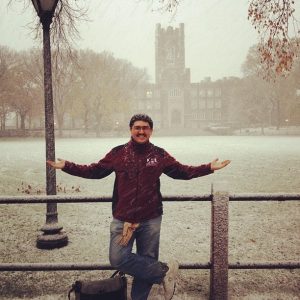
He says the internship combined with his Gabelli education prepared him for a successful career that gives him the capacity to support the people and causes he cares about. He’s now an associate on the investment risk team at JPMorgan Chase.
Sarwar hopes to spread his dedication to education in his role as a board member of Fordham’s Young Alumni Committee and chair of the Philanthropy Subcommittee.
“I want to help expand access to Fordham,” he says, “because I believe in a Fordham education. I believe in its ability to transform lives because I experienced that.”
Sarwar is particularly excited for this year’s Fordham Giving Day, a 24-hour push of support for the University from noon on March 6 to noon on March 7. “It’s a united platform for everybody to cheer and come together, and it helps people remember their Fordham experience and expand that experience to others,” he says. “I encourage young alumni to give whatever they can, to remember their ties to Fordham and the value of their own education.”
Besides his work on Young Alumni Committee, Sarwar also informally advises Fordham’s Model U.N. Club as well as the Muslim Student Association, a club he helped reinvigorate when he served as president in his first two years at Fordham. “I also still read The Ram almost every week,” Sarwar says.
Sarwar plans to continue his involvement with Fordham and is looking forward to seeing it “continue to grow in the next decades as a source of not only academic and professional leadership but moral leadership,” he says.
“I think our world needs people who are smart, but we also need people who can act and think morally. And that is at the core of Fordham as a University.”
Fordham Five
What are you most passionate about?
I am passionate about helping spread access to education. I believe it’s the key to a happy, prosperous, and welcoming society. My family and I have been blessed with the opportunity to climb the socioeconomic ladder due to the high quality education we have been lucky to receive, and I dream of a world where that opportunity is available to all.
What’s the best piece of advice you’ve ever received?
Just before I left, one of my teachers in Pakistan asked me to always remember who I am and where I come from. Immigrants everywhere become de-facto ambassadors of their heritage, and he said to be mindful of that. His advice has helped me be a contributing member of the New York City community while retaining my identity.
What’s your favorite place in New York City? In the world?
Despite being a New Yorker for half my life, I am still exploring this ever-changing city. So far, my favorite places have been the lakes and secluded wooded areas in Central Park which give the illusion of being far from the hustle and bustle of the city. In the world, my favorite place is the home I grew up in in Pakistan because of all the memories there that I continue to carry in my heart.
Name a book that has had a lasting influence on you.
I received The Alchemist by Paulo Coelho as a high school graduation gift from Maurya Couvares, one of my mentors; it’s been a source of inspiration since then. The quest to find one’s true self is daunting, but Coelho’s allegorical tale serves as a constant reminder to keep pursuing it. The book was the perfect prelude to a Fordham education, as the tenets we were taught complemented Coelho’s message.
Who is the Fordham grad or professor you admire most?
I was fortunate to meet Father Patrick Ryan during my first month at Fordham when I was hanging signs around Eddies for a Muslim Students Association event. He became an instant mentor to me and also advised the growing club. His guidance was instrumental in helping MSA go from an almost defunct club to being awarded Club of the Year. I have been in awe of his vast knowledge and understanding of Islam. His biannual McGinley Chair Lectures bring together viewpoints from the three monotheistic religions and are the perfect embodiment of Jesuit values.
Father Patrick J. Ryan, the Laurence J. McGinley Professor of Religion and Society, suggested that the collisions of various empires might have signaled, supported, and even inspired reformation in Judaism, Christianity, and Islam.
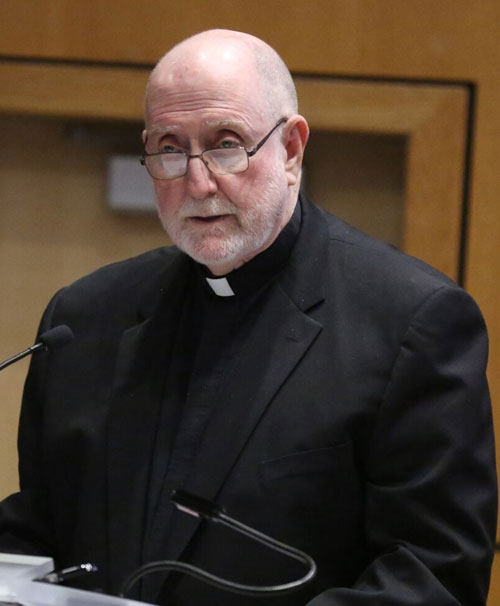
“Sometimes reformation has happened in reaction against colliding,” he said at the Nov. 14 lecture at the Lincoln Center campus. “At other times, the very collision of worlds has sparked reformation.”
Jerusha Tanner Lamptey, Ph.D., an assistant professor of Islam and interreligious engagement at the Union Theological Seminary, and Rabbi Daniel Polish, Ph.D., the spiritual leader of the Congregation Shir Chadash, acted as respondents to Father Ryan’s lecture.
A ‘tragic irony’
Father Ryan’s lecture, which coincided with the fifth centenary of the Lutheran reformation, took into account the reform movements that were incited by Kings Hezekiah and Josiah as well as the prophets Isaiah and Jeremiah. He also explored 19th century Reform Judaism.
“Reform Judaism enabled many hitherto purely nominal Jews or immigrant Jews to understand two basic elements of the faith, the oneness of God and the call of the chosen people to spread the light of monotheistic faith,” he said.
In the case of Christianity, Father Ryan stressed that the collisions of both empires and cultures have been significant in the Protestant reformations as well as the Anglican and Catholic reformations. He said that in the late 15th century, Europeans first encountered new worlds in the Americas, Asia, and Africa. But the agents of the Catholic reformation were more likely to evangelize these populations than Protestants, he said.
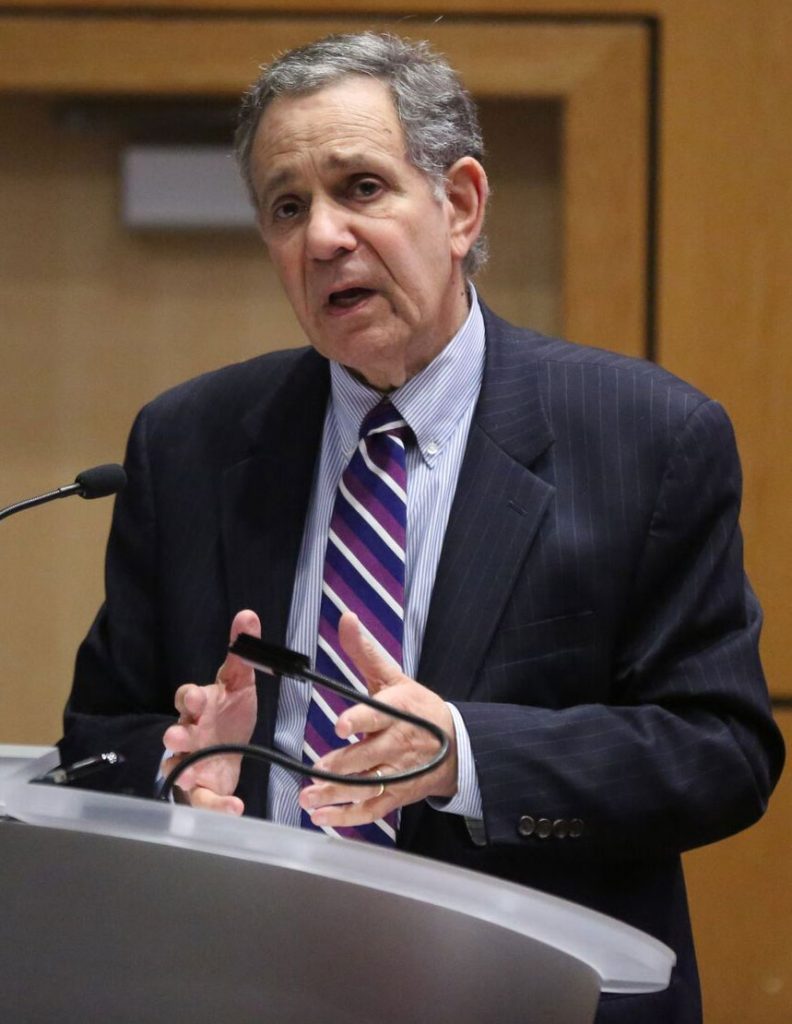
Father Ryan emphasized that Martin Luther was, however, eager to convert Jews after becoming convinced by Saint Paul’s Letter to the Romans that salvation would come to the Jews only after the evangelization of Gentiles was complete. The Lutheran reformation went down a dark path in 1543 when Luther published anti-Semitic writings that called for the violent destruction of the Jews.
“All of us who call ourselves Christian, heirs of one or another reformation—Protestant, Anglican or Catholic—need to examine our past in such a way as to liberate ourselves and our world from imprisonment in history,” he said.
Rabbi Polish likewise acknowledged Luther’s anti-Semitism, but said he was also struck by the commonalities of Reform Judaism and Lutheranism. Just as Luther rejected practices of the church that were not directly mandated in scripture, early reformers of German Judaism rejected the notion of an authoritative rabbinical interpretation of scriptures.
“Both Luther and early Jewish reformers shared commitment to the vernacular,” he said, adding that early Jewish reformers believed in a “perfect symbiosis of their German culture and their Jewish inheritance.”
Of course, this became a tragic irony in the context of the Hitler era, he said.
“The futile aspiration of early reformers to be accepted by their fellow Germans ended with the extermination of their community,” he said.
Authority in the past, present, and future
In his assessment of reform in Islam, Father Ryan affirmed that the first Muslims in seventh-century Arabia saw Islam as “a reform of what had come earlier in the Jewish and Christian tradition of faith.”
“Muhammad’s prophetic vocation made him, in the Islamic theology of history, the last of a series of great prophets and especially of those prophets who are characterized in Islamic tradition by the term rasul, messenger,” he said.
Father Ryan noted that between the 15th and the 19th centuries, Muslims like the Egyptian polymath Jalal al-din al-Suyuti and the northern Nigerian Usumanu dan Fodio considered themselves to be mujaddids or reformers of Islam.
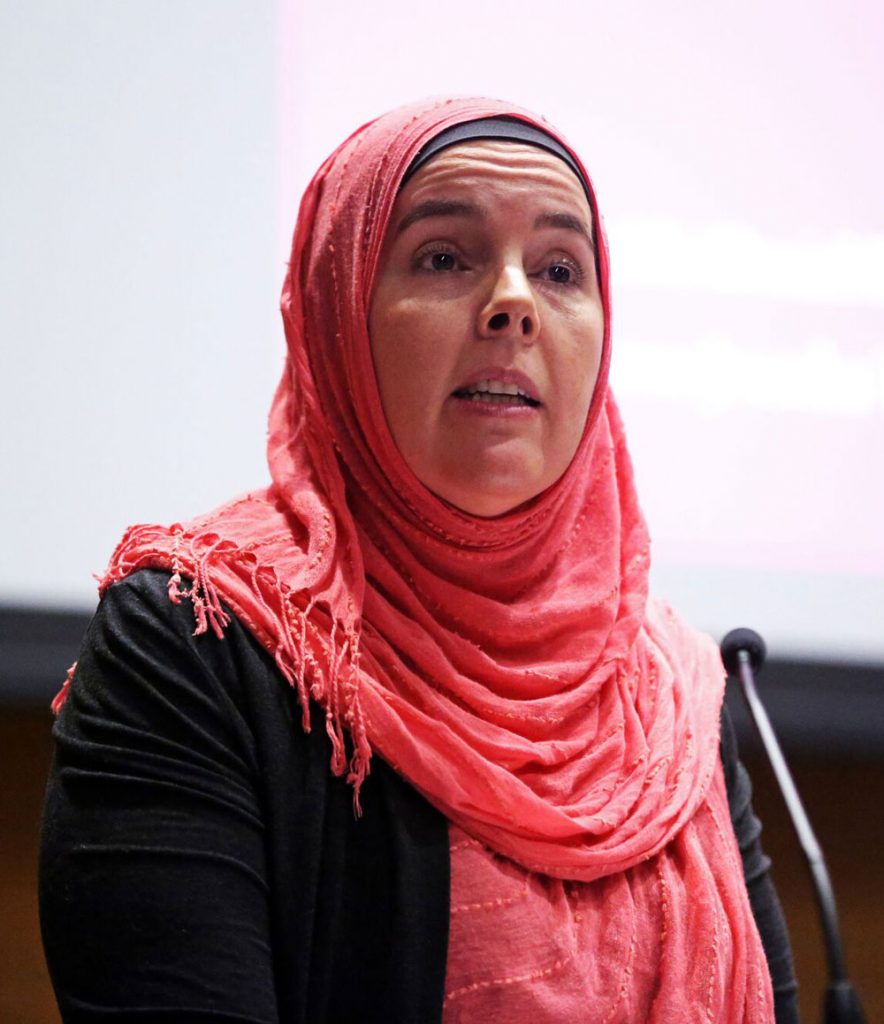
Self-described Mahdis or messianic leaders also started uprisings in Sudan and Saudi Arabia in 1881 and 1979, which coincided with the start of the 14th and 15th Muslim centuries.
Like the leaders before them, these reformers believed that they were responding to perceived threats to the Islamic tradition by great empires or repressive regimes, Father Ryan said. There are some echoes of this as well in the ISIS insurgency that assailed Syria and Iraq after 2014.
“That the partisans of ISIS first chose to create their ideal state across the borders of Iraq and Syria demonstrates how much ISIS is a delayed response to and reaction against European colonial parceling out of the central Arab world in the aftermath of World War I,” he said.
Lamptey cited trends in recent Islamic feminist interpretations of Islam as concrete examples of contemporary Islamic reform. She said these distinct interpretations were focused on egalitarian or a recovery of “real Islamic tradition’.”
“They argue that the Quran is fundamentally egalitarian, that it depicts an undifferentiated, ungendered human creation, [and]a divine sovereignty….and that the Quran is silent on any accounts of women in a secondary status,” she said.
While the Islamic feminist pioneers recognized that there were limitations and discrepancies in these interpretations, she said they attributed them to context and human interpretation.
“They seek to address those concerns by returning to the supposedly pristine beginnings and uncorrupted sources of the Islamic tradition,” she said.
]]>But this concept of authority and impartiality, according to Patrick J. Ryan, S.J., evolved a great deal over the years. In “Judging Justly: Judgment in Jewish, Christian, and Muslim Traditions,” Father Ryan, Fordham’s Laurence J. McGinley Professor of Religion and Society, explored how Jewish, Christian, and Muslim faiths contributed to that idea through their own unique traditions.
He framed his discussion of judgment with the tragic story of how three High Court judges in Ghana were murdered in 1982 precisely because they had given judicial redress to people convicted by a kangaroo court under a military regime.
In remarks delivered on March 28 and March 29 as part of the annual Spring McGinley Lecture,
Father Ryan delved into examples from scripture that illustrated how the faithful have struggled with concepts such as mercy and justice. In the Book of Genesis, he noted that God, whom Jews regard as the supreme judge, had a “crowded docket”: Weighing in on the fratricide of Cain, and condemning the corrupt and violent contemporaries of Noah yet sparing the ark-builder and his family.
In Christian scripture, he recalled an account in the Gospel of John, where Jesus is confronted by “the scribes and the Pharisees” asking him to judge a woman caught in the act of adultery. Jesus play-acted the role of judge, writing on the ground, and finally declaring, Jesus’ declaration “Let anyone among you who is without sin be the first to throw a stone at her.” illustrates the importance of impartiality and fairness.
“When Jesus finally rises from his play-acting, he finds that all the guilty accusers of the woman have departed, ‘one by one, beginning with the elders,’” Father Ryan said.
“One possible reason that the placement of this Gospel passage in the New Testament has proven so problematic may be that the discipline of the early church, in cases of adultery, was much less merciful than that of Jesus.” *
In Islam, as in Christianity and Judaism, God is also the ultimate judge, he said. His command and judgment are closely associated with the commands and judgments issued by the Messenger, the Prophet Muhammad. That practice continued after Muhammad’s death via judges who were concretized as the caliphs’ appointees in the Sunni tradition from the seventh to at least the 13th century, and the appointees of the imams in the Shi‘i tradition.
A qadi, or judge in the Sunni Muslim tradition, was appointed by the caliphs in the seventh century, and gradually began to exercise judicial functions in the eighth century, said Father Ryan. When the Turkish government suppressed the caliphate in 1924, however, a central religious-political institution was lost. Since then, Muslim judges are often appointed by national or regional governments. This has led to some controversial rulings in Nigeria, in particular, he noted, involving the amputation of hands for sheep-stealing, as well as overly zealous accusations of adultery against women based on circumstantial evidence only.
“Better trained Muslim judges, with expertise in comparative law and a broader vision of Islamic jurisprudence, can be found in many of the Gulf States,” he said. “But there have been highly problematic judgments handed down by judges, not only in northern Nigeria but also in Saudi Arabia and Egypt in recent decades.”
Respondents to Father Ryan’s lecture included Sarit Kattan Gribetz, Ph.D., assistant professor of theology at Fordham, and Ebru Turan, Ph.D., assistant professor of history at Fordham. Gribetz highlighted two passages from Genesis Rabbah and the Babylonian Talmud and one from the Torah that illustrate the ongoing debate between mercy and justice in God’s mind. God is compared to a king who holds up two empty cups and notes that they will crack when filled with cold water and burst when filled with hot water. The temperatures are stand-ins for too much mercy and too much justice.
“[They] represent radical extremes-order and chaos, suffocating restriction and unbounded freedom. Each on their own is assumed to be too dangerous—so dangerous that it will shatter, crack or deform the world,” she said.
Turan further developed Father Ryan’s history of how the role of judge developed historically in the Muslim tradition. The Ottoman Empire, from the 13th to the early 20th century, developed a system of training legal scholars for such posts. With the break-up of the Ottoman Empire after 1918, modern Turkey appoints judges with a much more secular orientation.
Father Ryan said offered three conclusions from the faith traditions’ experiences with justice:
-Judges need protection from manipulative politicians, established ruling classes, and populist demagogues. He cited as examples the Roman-dominated Hebrew sanhedrins, Pope Urban II commanding Christian knights to go on Crusade, and modern “Muslim muftis” who “declare every military adventure of a Middle Eastern dictator a jihad.”
-Judges should have excellent legal credentials, a deep understanding of the law in their own tradition, and a sense of comparative law. There is no room in the courtroom for mediocre judges.
-Judges benefit from differences in legal opinion, or “ikhtilaf,” an Islamic concept being promoted by movements concerned with the status of Muslim women. This contrasts with the generally approved idea of Islamic legal consensus, or “ijma,” relied on by Orthodox Jews, Catholic Christians, and the various Eastern Christian Churches.
]]>Wisdom and Learning.
Inspired by this motto, Patrick J. Ryan, S.J, Laurence J. McGinley Professor of Religion and Society, made it the central focus of this fall’s McGinley Lecture, which took place Nov. 15 at the Lincoln Center campus and Nov. 16 at the Rose Hill campus.
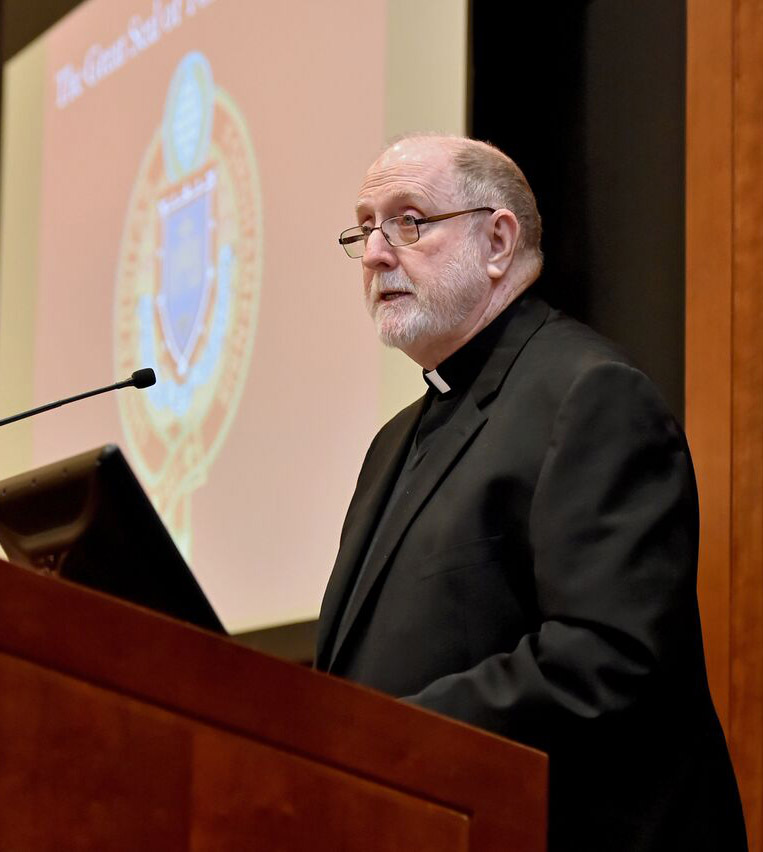
The lecture, “Wisdom and Learning: Higher Education in the Jewish, Christian and Muslim Traditions,” acted as a conversation between the traditions of the People of the Book, with Magda Teter, Ph.D., Shvidler Chair in Judaic Studies, representing Judaism, and Ebru Turan, Ph.D., assistant professor of history, representing Islam.
Father Ryan noted that the notion of wisdom is prevalent in all three religious traditions because it “enables us to attain to an overarching moral and spiritual perspective on our world.”
“It prompts us to discern how learning or knowledge should be used and how to live as perceptive and virtuous citizens of our world,” he said.
Just as the three traditions share spiritual roots, they also share educational ones; some of their structures of higher learning all come from the ancient Greeks. However, as the religions began to develop and change, so did their educational structures.
“The Jewish and Christian and Muslim traditions of education have diverged greatly on the detailed contents of their curricula,” said Father Ryan.
In the Jewish tradition, education is an important aspect of the faith’s identity, said Teter, who talked about the difficulties Jews faced in the modern era when entering institutions of higher education.
“Jews were excluded from education until the 19th century,” said Teter, “and even when they were accepted, many schools did not support Jewish studies—or forced the students to learn from the Christian perspective. They lost their identity in their own story.”
The Jewish response was to create its own educational institutions, which began to thrive in the early 1900s, she said. It allowed Jewish populations to continue spiritual instruction outside the synagogue and the home, creating the chance to integrate into society.
Islamic instruction, which is heavily based on the memorization of the Qur’an, embraced higher education because it standardized Muslim beliefs, said Turan.
“Higher education provided a cohesiveness and unity to medieval Islam,” she said. “It gave Islam a global identity.”
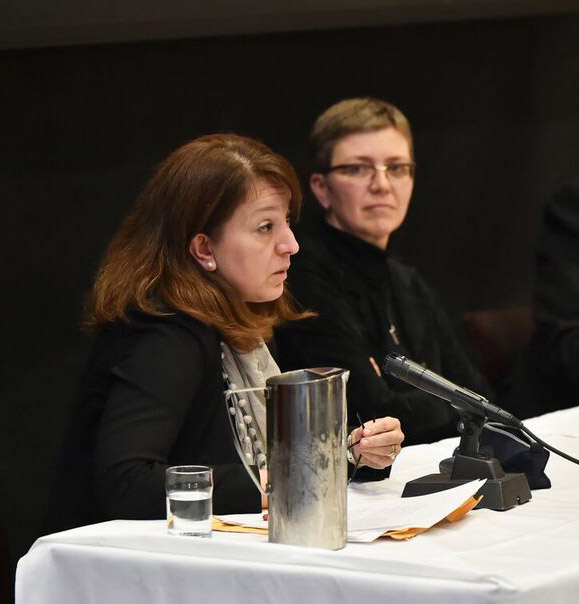
Muslim schools called madrasas, derived from the Arabic word “to learn,” focused on law, theology and logic in their earliest iterations. Now, there are Muslim universities around the world that provide a diverse selection of study. Turan said that the translation of the Qur’an into other languages allowed Islam to be studied by a greater population.
“The translation . . . empowered Islamic education and opened it up to the rest of the world.”
In the Catholic tradition, Ignatius of Loyola, founder of the Jesuits, complimented university education with humanistic studies. By drawing from his own experiences at the University of Paris, Ignatius wanted to ensure that his students “went through systematic humanistic training in grammar, literature, and rhetoric.”
Jesuit education evolved around this foundation and now includes a diverse selection of fields of study. Father Ryan stressed that Ignatius’ humanistic training is ingrained in Jesuit education’s infrastructure.
“No one finishes any undergraduate college at Fordham without some exposure to philosophy, theology, literature, the natural and social sciences,” he said.
A Q&A segment following the lectures raised the question “Will the three faiths ever agree on the definition of wisdom?”
In response, the panelists laughed.
“We are all conscious that wisdom is important to our faiths and recognize it is something worth pursuing,” said Turan. “But besides that, I think we are fine agreeing to disagree.”
–Mary Awad
]]>Beneath the philosophical arguments was a deeply personal connection to the discussion, via the bloodshed that engulfed Ireland a century ago.
In Making War, Making Peace: Jewish, Christian, and Muslim Attitudes, Patrick J. Ryan, SJ, the Laurence J. McGinley Professor of Religion and Society, explored the ways in which Judaism, Christianity and Islam balance the fraught issue of when people have a right to wage war, and when not.
Divine Authorization
Regarding war in ancient Israel, Father Ryan said that Israel’s faith centered not only on liberation from bondage but also on divinely authorized territoriality. This meant the settlement of Abraham’s descendants in erez Yisrael, “the land of Israel.”
At the same time, Father Ryan said that Jewish faith also embraces a vision of God who has compassion not only for the people of Israel but also for their enemies. In the Talmud, God admonishes angels celebrating the Exodus, saying of the dying Egyptians, “My handiwork is drowning in the sea. Would you utter a song before me?”
Christian Principles for Just War
In the 5th century, Augustine was the first Christian theologian to develop a concept of just war, said Father Ryan. Medieval definition of just war, however, sometimes involved a certain “fatal subjectivity,” especially when Crusaders took up arms to fight Muslims as a form not of war but of doing penitential pilgrimage for their sins.
Thomas Aquinas offered three principles to define just war in the 13th century, said Father Ryan. One principle, “rightful intention,” presumed that just wars avenge injuries inflicted, a principle that is vulnerable to immense possibilities for misuse.
Father Ryan also quoted Aquinas to the effect that sometimes “‘war is declared by a legitimate authority and for a just cause, but is nevertheless rendered unlawful through a wicked intention.’”
As examples of wicked intentions and the wicked actions that flow from them, Father Ryan pointed to “enhanced interrogations” by the CIA in 2002 and the water boarding and sexual humiliation of enemy combatants by U.S. army personnel at Abu Ghraib in 2004, as well as the deployment of atomic bombs on Hiroshima and Nagasaki in 1945.
The Meaning of Jihad
Regarding Islamic faith, Father Ryan disputed the notion that jihad means “holy war.” Jihad originally denoted “struggle,” especially the struggle to recuperate what was lost when the prophet Muhammad and his companions had to leave Mecca for Medina. Jihad cannot justify terrorist violence, nor is it ever to be waged against fellow Muslims, as is done by ISIS.
Father Ryan singled out Bacha Khan, a 20th-century Pushtun from Pakistan, as the greatest Muslim pacifist struggler of the past century. Inspired by Mahatma Gandhi, Khan formed an unarmed Pashtun Muslim militia that practiced non-violence even when confronted with lethal force by the British in India.
Respondents to Father Ryan’s lecture included Sarit Kattan Gribetz, assistant professor of theology at Fordham, and Mehnaz Afridi, assistant professor of religious studies at Manhattan College. Professor Gribetz spoke about the homelessness war so often produces, citing the example of her own father’s lonely departure from Baghdad for Israel at the age of 8. Professor Afridi, a Muslim specialist on the Holocaust, spoke of the way Holocaust victims have tried to cope with the horrors of war they have experienced and have even thought of themselves as waging war to make peace.
A Family Narrative on the 100th Anniversary of the Irish Republic
Father Ryan began and ended his lecture with a family narrative about war and peace dating back to the Irish struggle for independence a hundred year ago. Because of wrongs inflicted against the Irish under British rule, the leaders of the 1916 Easter uprising argued that their struggle was just, said Father Ryan. They ascribed to the Provisional Government of the Irish Republic what Aquinas called “the authority of a ruler.”
“Both making war and making peace are arduous tasks,” Ryan contended. To illustrate this he detailed the history of a father in Tipperary taken hostage in the Irish war of independence by Harry Biggs, a much-hated British District Inspector, in retaliation against the father’s two IRA sons.
Biggs was ambushed and killed while driving on a country road on May 14th, 1921. A civilian passenger was also killed by accident—Winifred Barrington, the 25-year-old daughter of local British settler gentry. The man who killed Biggs, said Father Ryan, was the older son of the hostage Biggs had maltreated.
Elected to Dail Eireann in the subsequently created Irish Free State, the man who shot Biggs refused to take the required oath of allegiance to the King. Emigrating to New York in 1929, he married and started a family, but died in 1944, just after his 45th birthday.
Father Ryan concluded his presentation with a prayer for the dead. “May the souls of the signers of the Proclamation executed a century ago this spring, the souls of Winifred Barrington and Harry Biggs, and the soul of the man who shot Biggs in May 1921—my father, Paddy Ryan ‘Lacken’—rest at long last in peace.”
]]>On Nov. 10 and 11, Patrick Ryan, SJ, the Laurence J. McGinley Professor of Religion and Society, made that brief document the focus of his fall McGinley lecture.
The document, 1,152 words in length, dedicated 433 words to the Jewish faith but only 133 words to Islam.
“Each section deserves careful analysis; each has a pre-history as well as a post-history with which we are living to the present day,” he said.
Father Ryan said some of the document’s pre-history included a tradition of anti-Semitic bias among Christians that cried out for “authoritative rejection” by the Church.
Father Ryan noted that one passage, in particular, repeated the early Church’s rejection of the teaching of the second-century heretic, Marcion of Sinope, who rejected everything that was Jewish in the Christian tradition. Paraphrasing St. Paul’s teaching that reaffirms God’s continuing love for the Jews, Father Ryan showed how the Council document rejects centuries of anti-Jewish hatred.
“[B]ut as regards election [the Jews]are beloved, for the sake of their ancestors; for the gifts and the calling of God are irrevocable,” Father Ryan quoted from St. Paul’s Letter to the Romans.
“Nineteen centuries of Gentile-Christian hatred of the Jews as enemies of Jesus, himself a Jew, are here clearly renounced,” he said.
Father Ryan noted that the document’s short section on Muslims is not as detailed as the section about Jews. However, even the statement that the Church “regards Muslims with esteem” is an about-face in Church attitudes, very different from a prayer composed by the papacy just four decades earlier that asked God to “illuminate the minds of those still involved in the darkness of idolatry or of Islamism.”
“The document recognizes the centrality of Abraham to the faith of the Muslims,” he said, but it also acknowledges the long history of tension between Christians and Muslims that reached its apex during the Crusades.
“Nostra aetate, brief as it is, and especially its section on Muslims, marks a starting point for the process of dialogue between Christians and Muslims—perhaps even among Jews, Christians, and Muslims—that must be continued today and tomorrow for the sake of humankind and for the glory of God.”
The McGinley Lecture was followed with responses from Jewish and Muslim perspectives. This year’s Jewish response came from Magda Teter, PhD, the recently appointed Shvidler Professor of Judaic Studies.
Teter said the document represents both tradition and change in a complex way, and should be defined more by what followed it than by its actual content. It became a springboard for new dialogue between Jews and Christians. Still, she said the conciliatory voice was charged with facing down centuries of blame for the death of Christ.
“Jews lived this curse around the world,” she said.
Professor Hussein Rashid, PhD, a faculty member from Hofstra University, shared the Muslim point of view. He said that while Nostra aetate certainly spurred new conversations, it was burdened by a cultural memory that carries hope alongside stigma.
Rashid said he found hope in Pope Francis’ recent visit to the 9/11 memorial, where he said the stigma of the “cultural memory that Muslims are the violent Other” still lingers.
“Yet in listening to the words of Pope Francis spoken there, we understand that he saw the location as a transforming space in our relationship with each other,” said Rashid.
“It is in Pope Francis that we see the embodiment of Nostra aetate . . . the rejection of the worst in us and a commitment to the best in us, inspired by the vision of a more peaceful society, [and]the transformation through acts and a deep listening to each other that is our challenge for the next 50 years.”
]]>
Patrick J Ryan, S.J., the Laurence J. McGinley Professor of Religion and Society, will deliver the annual fall McGinley lecture, “Life After Death, Hopes and Fears for Jews, Christians and Muslims.”
Father Ryan, who has dedicated his work to facilitating a trialogue between the three Abrahamic religions, will deliver the lecture twice:
Tuesday, Nov. 13
6 p.m.
12th-floor Lounge
Lowenstein Center, Lincoln Center Campus
And again on
Wednesday, Nov. 14
6 p.m.
Flom Auditorium
William D. Walsh Family Library, Rose Hill Campus
Joining Father Ryan on both nights will be respondents Claudia Setzer, Ph.D., professor of religious studies at Manhattan College, and Hussein Rashid, Ph.D., adjunct assistant professor of religion at Hofstra University.
The lectures are free and open to the public.
The McGinley Lecture is delivered biannually as part of the Laurence J. McGinley Chair in Religion and Society. Father Ryan has held the chair since 2009. The lecture endeavors to facilitate a trialogue between people of Jewish, Christian and Muslim faiths.
Previously held by Avery Cardinal Dulles, S.J., the chair was founded in 1988 to attract distinguished scholars interested in the interaction of religion with the legal, political and cultural forces in our pluralistic American society.
For more information, contact (718) 817-4745 or [email protected], or visit the website.
]]>